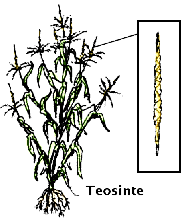
| 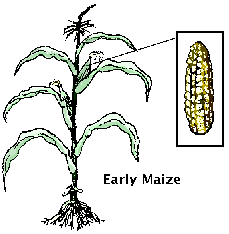
|
Evolution of Maize Agriculture
Corn or maize (zea mays) is a domesticated plant of the Americas. Along with many other indigenous plants like beans, squash, melons, tobacco, and roots such as Jerusalem artichoke, European colonists in America quickly adopted maize agriculture from Native Americans. Crops developed by Native Americans quickly spread to other parts of the world as well.

| 
|
Over a period of thousands of years, Native Americans purposefully transformed maize through special cultivation techniques. Maize was developed from a wild grass (Teosinte) originally growing in Central America (southern Mexico) 7,000 years ago. The ancestral kernels of Teosinte looked very different from today's corn. These kernels were small and were not fused together like the kernels on the husked ear of early maize and modern corn.

|
By systematically collecting and cultivating those plants best suited for human consumption, Native Americans encouraged the formation of ears or cobs on early maize. The first ears of maize were only a few inches long and had only eight rows of kernels. Cob length and size of early maize grew over the next several thousand years which gradually increased the yields of each crop.
Eventually the productivity of maize cultivation was great enough to make it possible and worthwhile for a family to produce food for the bulk of their diet for an entire year from a small area. Although maize agriculture permitted a family to live in one place for an extended period of time, the commitment to agriculture involved demands on human time and labor and often restricted human mobility. The genetic alterations in teosinte changed its value as a food resource and at the same time affected the human scheduling necessary for its effective procurement.
Maize in New England
As the lifeways of mobile hunting and gathering were often transformed into sedentary agricultural customs, very slowly the cultivation of maize, along with beans and squash, was introduced into the southwestern and southeastern parts of North America. The practice of maize agriculture did not reach southern New England until about a thousand years ago.
A Penobscot man described the transformation of maize for the shorter growing season of northern New England. Maize was observed to grow in a series of segments, like other members of the grass family, which took approximately one phase of the moon to form, with approximately seven segments in all, from which ears were produced only at the joints of the segments. Native Americans of northern New England gradually encouraged the formation of ears at the lower joints of the stalk by planting kernels from these ears. Eventually, as ears were regularly produced at the lower joints of the cornstalk, the crop was adapted to the shorter growing season of the north and matured within three months of planting.
Native Americans of New England planted corn in household gardens and in more extensive fields adjacent to their villages. Fields were often cleared by controlled burning which enriched not only the soil but the plant and animal communities as well. Slash and burn agriculture also helped create an open forest environment, free of underbrush, which made plant collecting and hunting easier.
Agricultural fields consisted of small mounds of tilled earth, placed a meter or two apart sometimes in rows and other times randomly placed. Kernels of corn and beans were planted in the raised piles of soil to provide the support of the cornstalk for the bean vine to grow around. The spaces in between the mounds were planted with squash or mellon seeds. The three crops complemented each other both in the field and in their combined nutrition.
Native Americans discovered that, unlike wild plants and animals, a surplus of maize could be grown and harvested without harming their environment. Tribes in southern New England harvested great amounts of maize and dried them in heaps upon mats. The drying piles of maize, usually two or three for each Narragansett family, often contained from 12 to 20 bushels of the grain. Surplus maize would be stored in underground storage pits, ingeniously constructed and lined with grasses to prevent mildew or spoiling, for winter consumption of the grain.
The European accounts of Josselyn in 1674, indicate Native Americans used bags and sacks to store powdered cornmeal, "which they make use of when stormie weather or the like will not suffer them to look out for their food". Parched cornmeal made an excellent food for traveling. Roger Williams in 1643, describes small traveling baskets: "I have travelled with neere 200. of them at once, neere 100. miles through the woods, every man carrying a little Basket of this [Nokehick] at his back, and sometimes in a hollow Leather Girdle about his middle, sufficient for a man three or foure daies".
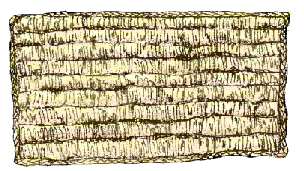
| 
|
| Cornhusk bed mat; Iroquois.
Rolled husks sewn with basswood cord. Braided Edge. | Cornhusk foot mat; Seneca.
Braided and sewn in a coil. Fringe from spliced cornhusks left on one side. |
Native American Origins of Maize
Many Native American traditions, stories and ceremonies surround corn, one of the "three sisters" (maize, beans and squash). Even in New England there are many variations on how maize was brought or introduced to Native Americans here. Generally in southern New England, maize is described as a gift of Cautantowwit, a deity associated with the southwestern direction; that kernels of maize and beans were delivered by the crow, or in other versions the black-bird. Responsible for bringing maize, the crow would not be harmed even for damaging the cornfield. Other Algonquian legends recount maize brought by a person sent from the Great Spirit as a gift of thanks.
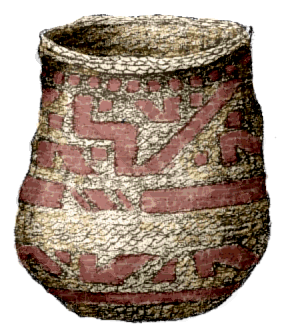
| 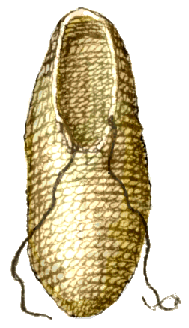
|
| Cornhusk, wool and basswood cord
twined bag; Narragansett (made in 1675). | Cornhusk moccasin; Seneca.
Two-strand twined construction. |
New England tribes from the Mohegan in Connecticut to the Iroquois in the Great Lakes region had rituals and ceremonies of thanksgiving for the planting and harvesting of corn. One ceremony, the Green Corn ceremony of New England tribes, accompanies the fall harvest. Around August Mahican men return from temporary camps to the village to help bring in the harvest and to take part in the Green Corn ceremony which celebrates the first fruits of the season. Many tribes also had ceremonies for seed planting to ensure healthy crops as well as corn testing ceremonies once the crops were harvested.

|
Text and Graphics
© 1994 - Tara Prindle unless otherwise cited. |